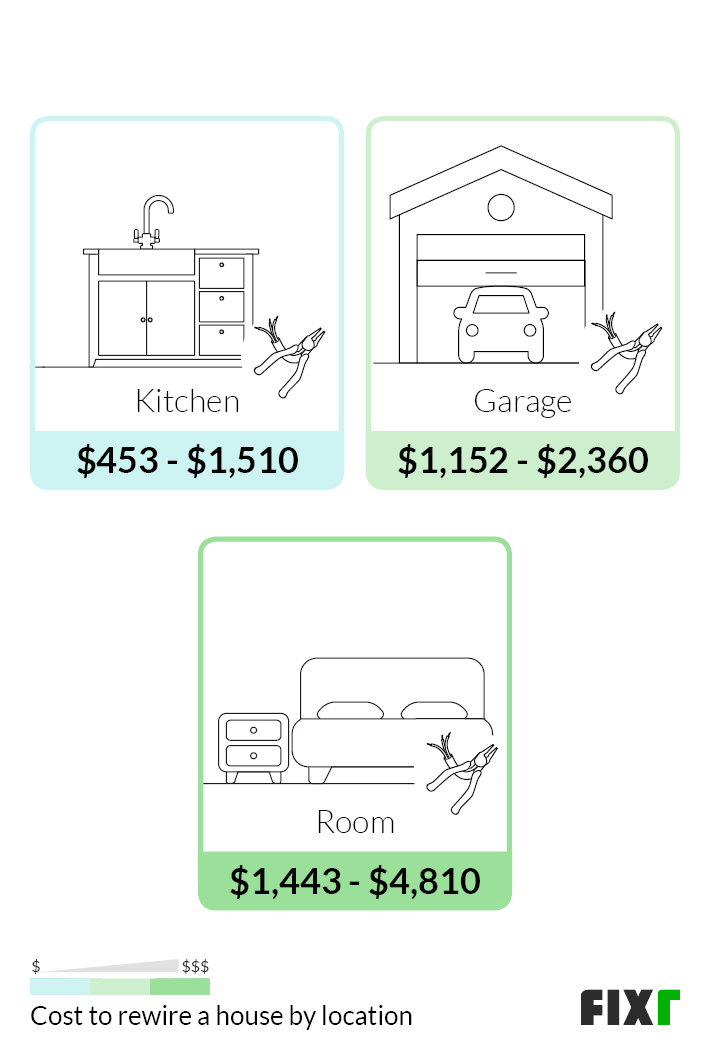Table Of Content

Before you take on your next home wiring project, arm yourself with basic information about the electrical cable and wiring that you’re likely to see. Modern receptacles are called “duplex receptacles” because they have two screws on both sides. As the name implies, they can bring electrical current into one set of screws and then send it out on the other “duplex” set of screws to another fixture. For applications such as wiring a light fixture, the fixture’s wires are joined to the electrical supply wires with wire nuts.
How long does it take to wire a house?
Remember, it’s safest to let an electrician handle the electrical work. But you can still repair walls yourself to help cut down on labor costs. If possible, have your pro pull old wires through your crawlspace, attic, basement or floor joists rather than through breaking down walls. Many electricians can fish wire through the walls of your home to avoid costly wall repair services.
Sign up for Free ProjectCost Information
And if you’re wondering why that one outlet keeps tripping, Why Multiple Electrical Outlets Not Working? Switches are the unsung heroes of the electrical world. And for rooms with multiple entrances, three-way switches are a godsend.
Hiring Professionals vs. DIY
These diagrams show the power source and voltage, as well as the loads (lights and equipment) and any components that affect the flow of electricity, like switches. This type, called a schematic, is most often used by engineers and other electrical professionals. And no matter how much money you need to save, you shouldn’t try to DIY an electrical project.
Create Your Plan
Electrical wire is typically made of copper or aluminum, and these conductive materials are insulated as wires that bring electricity to various parts of your home. When you're installing new wiring, choosing the right wire or cable is half the battle. When working with electricity, it's essential to put safety before speed or efficiency, especially if you are relatively new to working on electrical upgrades or repair projects. Before starting the project, it’s essential to have a basic understanding of the electrical system and to invest in proper protective equipment.
Best powerline extenders for 2024 - Tom's Guide
Best powerline extenders for 2024.
Posted: Mon, 08 Apr 2024 07:00:00 GMT [source]
Get free, objective, performance-based recommendations for top real estate agents in your area. Browse profiles, see prices and use filters to find pros who match your project. Your land location might also require excavation to successfully place the cable and conduits underground or a more durable cable that can withstand weather and other elements. More complex systems like the CT room have a diagram showing the system’s overall layout, as well as more detailed diagrams of the individual components and how they’re tied together. While DIY is fun, there’s no harm in getting a second opinion. Consulting with a pro ensures your plan is not just good but electrifyingly great!
Cable by the Numbers
Larger appliances such as electric stoves, electric water heaters, electric dryers and central air units will often use 10-, 8- or even 6-gauge wire. For example, a junction box with 18 cubic inches of volume can hold up to nine #14 AWG wires. But if the box contains one electrical outlet, you must subtract two wires. The box could then hold up to seven #14 AWG wires (plus the outlet). Much of what you need to know for electrical repairs involves how to identify, buy, and install electrical wiring. Here are all the basic elements you need to understand about electrical wiring.

Not All Cable Is Color-Coded
Additionally, familiarize yourself with local electrical codes. While you can handle some basic tasks, it’s recommended to consult with a professional electrician for complex wiring to ensure safety and compliance with regulations. With your plan in place and a professional’s nod, it’s time to roll up those sleeves. No DIY project is worth a shock, literally or figuratively. Always turn off the main power, and if you’re unsure, consult a professional. Remember, it’s better to be safe than sorry (or electrocuted).
The final word on rewiring
Likewise, larger homes need more wire and take longer to rewire, leading to higher costs. For example, the average size home is 2,500 square feet. If you plan on rewiring your entire home, then you’ll need roughly 2,500 feet of wiring material. Installing a new electrical panel is similar to the price of replacing or upgrading an electrical panel, at $1,500 to $4,000. A small, 800-square-foot home will run about $2,400 to $4,000.
Brightline West says electric-powered trains will cut the four-hour trip across the Mojave Desert to a little more than two hours. It projects 11 million one-way passengers per year, with fares that Edens said will be comparable to airline ticket costs. The trains will offer rest rooms, Wi-Fi, food and beverage sales and the option to check luggage. National estimates indicate that it takes three to 10 days to rewire a home. Grantham, however, recommends planning for about two weeks of work in the home, which includes the actual rewiring, any necessary repairs, and the finishing touches. Millions of people ask Thumbtack for help with their projects every year.
Finish up by calling an electrician for an inspection before you cover the wiring access points. Before starting this job, it’s a good idea to have a basic understanding of the various parts of a light switch and how a light switch works. The components include a toggle or rocker, contacts, screw terminals, line wire, load wire, and neutral wire.
If your electrical panel (breaker box) is undersized, replacing it with a larger one will let you use more electronics and appliances at once. If you’re planning to sell an old home with electrical issues, you might need to rewire the home to secure an offer. Furthermore, a working electrical system won’t necessarily add value to your home, even if it’s copper, Stewart notes.
Henry lives in Florida with his wife and two kids, and enjoys spending his free time on DIY projects around the house. You can find some of his work on Today’s Homeowner, where he is a regular contributor. Always turn off the main power when working, use insulated tools, and wear protective gear.
These are simple connections with the live and neutral wires connected accordingly. The switch two gets connected to the ceiling fan via a dimmer switch or a regulator to increase or decrease the fan speed. If you decide to stay in your house, talk with your contractor to learn what will be done in what area at what time.

No comments:
Post a Comment